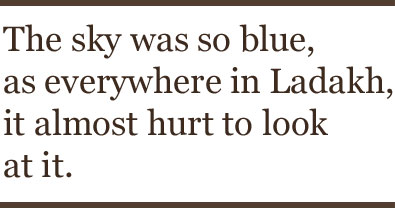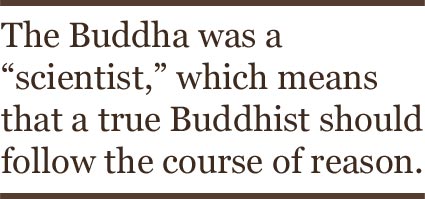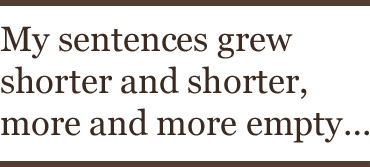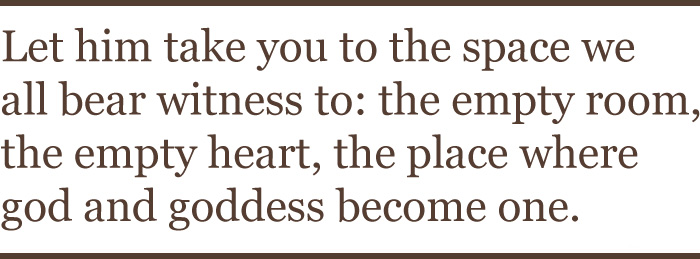It is not answers that pull many people into the religious life, it is questions. The person who lives deeply and enduringly with, and within, a religion often finds that he is surrounded by ever more doubts as he goes on, not convictions. In an eloquent monk like Thomas Merton, say, the religious impulse is almost fired by a kind of holy restlessness, as if, each time the traveler ascends a peak, he sees nothing but the larger peaks that now confront him. “Our knowledge,” as Isaac Bashevis Singer, setting golems at play amidst highly fallible humans, puts it, “is a little island in a great ocean of non-knowledge.” Religion is in that regard like that other (one hopes lifelong) affair of the spirit and the heart, marriage. I may know my partner inside out, in terms of her habits and her gestures, and yet the more I see of her, the more I have to acknowledge how much will always lie beyond my reckoning–and in that very space of unknowing, my hunger for a continuing relationship may be quickened.
This is not always what people want when they turn to the imagined solace and sustenance of religion and that, perhaps, is why many of us take shelter inside belief systems, which lay down unequivocally what is and is not kosher, who’s with us and against us, a creed that is fixed and even finished product. As James Carse puts it, in his typically quotable and suggestive way, in his latest book, belief systems depend on boundaries as much as the religious impulse (as he defines it) relies on horizons. A boundary is clear-cut, and (its makers sometimes hope) will never change; a horizon, dependent on where you’re standing, alters every time you walk towards it.
 A longtime director of the religious studies program at New York University, Carse is the author of five previous books, such as Breakfast at the Victory, which show him to be an engagingly witty and compelling spirit, who can plunge into discussions of the Unsayable and the mysterium with a striking gift for the memorable epigram and for the fine distinction. True to the very ideas he speaks for in The Religious Case against Belief, this does not always make him an authoritative, or even persuasive, writer; rather it turns him into a kind of agile provocateur, eager to prize us out of our set positions, to get us thinking, even perhaps to move us to form counter-arguments of our own. A professor (emeritus now) who writes for the enquiring common reader, he contrives to make the thrashing out of essential issues both urgent and enjoyable.
A longtime director of the religious studies program at New York University, Carse is the author of five previous books, such as Breakfast at the Victory, which show him to be an engagingly witty and compelling spirit, who can plunge into discussions of the Unsayable and the mysterium with a striking gift for the memorable epigram and for the fine distinction. True to the very ideas he speaks for in The Religious Case against Belief, this does not always make him an authoritative, or even persuasive, writer; rather it turns him into a kind of agile provocateur, eager to prize us out of our set positions, to get us thinking, even perhaps to move us to form counter-arguments of our own. A professor (emeritus now) who writes for the enquiring common reader, he contrives to make the thrashing out of essential issues both urgent and enjoyable.
In his new book Carse builds upon a typically intriguing and contentious distinction between religion and belief–or what is really a subtler distinction between open-ended, tolerant enquiry and a doctrine that knows what it knows and is not keen to hear about anything else (implications for our current political situation and for the argument between liberalism and Fundamentalism run beneath every sentence in the book, though Carse chooses not to bring many of them explicitly to the surface). “The act of belief,” as he has it, “is always an act against {itals}; it requires an opponent who holds the contrary belief.” Knowledge, for him, is “corrigible,” and belief “rarely so.”
This will not convince the believer, and in fact the attempt to rescue the religious life from the “true believer”
may be the secret impetus behind this work. By creating his own highly subjective and perhaps questionable definition of terms like “knowledge” and “belief,” Carse in some ways loads the argument and settles it before he undertakes it, a kind of philosophical preaching to the converted. Yet the very conviction and fluency with which he advances his ideas gives his work something of the debater’s charm and engagement of such counter-works as Christopher Hitchens’s God is not Great and Sam Harris’s The End of Faith. And though he never tells us what his own religious affiliations might be–this reader guesses tolerant Christian–Carse, as a lifelong professor of religious studies, is in a strong position to argue that the recent broadsides against faith fail to acknowledge the fundamental divisions within religions–or between enlightened skeptics and believers–that are in fact true religion’s life-blood.
In order to give flesh and immediacy to his position, Carse begins by re-telling the story of Galileo, a man who had a profound and unshakable religious conviction–as well as an unswerving devotion to science and its principles of empiricism and objectivity. Galileo, in other words, was able to give himself entirely to both faith and reason, as one might to one’s job and one’s spouse, seeing that they belong to dimensions as different as the apple and the orange. The Inquisition, by contrast (in Carse’s characteristic phrasing), represented the real heresy, precisely because its prosecutors were not inquisitive enough. They were what Carse would call “believers,” locked inside a system they were determined should never budge– where Galileo, for him, was in the party of religion, true knowledge, a genius at “finding questions at the heart of the most certain of answers.”
As he goes on, Carse takes us through the life of Martin Luther, again to show us how the very changes that most of us undergo throw into question the validity of unchanging beliefs; life, in other words, is much more fluid and contradictory than the ideas we sometimes impose on it (I was reminded at such moments of the sign I saw up this year outside the chapel at Gethsemane, just outside Jerusalem–aimed at too-voluble tour-guides: “PLEASE No Explanations Inside the Church”). The obvious point to make about Luther’s confrontation with the Roman Emperor Charles V is that each of these learned, committed Christians saw the other as an agent of the devil, because each sat inside incompatible (and inflexible) sects within the same Church and readings of the scriptures. But the deeper and more interesting point is that once the excommunicated Luther retreated into a cell and intensified his studies in the Bible, he decided that his greatest adversary was the enemy within, and called himself simul justus et peccator {itals}, at once a just man and a sinner. Once (in Carse’s scheme of things) an immovable believer, he grew into an apostle of true religious knowledge.


 It was hard to believe that only ninety minutes earlier we’d been in the Ladakhi capital of Leh, 8000 feet below. We were now stranded in what seemed like snowfields, ragged prayer-flags hanging between great boulders all around us. Here and there Indian soldiers shivered in their tattered encampments. The Sikh officer who had checked my passport some minutes before, at 15000 feet, a helicopter whirring overhead, had startled me by suddenly bursting into song, along with his radio. Perhaps he had decided to live out the first rule of survival at high altitude written up on a nearby board: “Always Have a Cheerful Attitude.”
It was hard to believe that only ninety minutes earlier we’d been in the Ladakhi capital of Leh, 8000 feet below. We were now stranded in what seemed like snowfields, ragged prayer-flags hanging between great boulders all around us. Here and there Indian soldiers shivered in their tattered encampments. The Sikh officer who had checked my passport some minutes before, at 15000 feet, a helicopter whirring overhead, had startled me by suddenly bursting into song, along with his radio. Perhaps he had decided to live out the first rule of survival at high altitude written up on a nearby board: “Always Have a Cheerful Attitude.” How the crisis unfolds will be determined not just in Beijing but also by the words and actions of a man who protects his people from afar, in his exile home in the northern-India hill station of Dharamsala. As a Buddhist monk, the Dalai Lama speaks unstintingly on behalf of all people’s rights to basic freedoms of speech and thought—though as a Buddhist monk, he also holds staunchly to the view that violence can never solve a problem deep down. If the bloodshed gets out of control, he said in recent days, he will step down as political leader—a symbolic act, really, since he would continue to be the head of the Tibetans and the democracy he has set up in exile already has an elected Prime Minister. In China meanwhile, Tibetans are still liable to imprisonment for years just for carrying a picture of their exiled leader (who by Tibetan custom is regarded as the incarnation of a god, the god of compassion). Some have been shot while walking across the mountains to visit cousins or children in exile.
How the crisis unfolds will be determined not just in Beijing but also by the words and actions of a man who protects his people from afar, in his exile home in the northern-India hill station of Dharamsala. As a Buddhist monk, the Dalai Lama speaks unstintingly on behalf of all people’s rights to basic freedoms of speech and thought—though as a Buddhist monk, he also holds staunchly to the view that violence can never solve a problem deep down. If the bloodshed gets out of control, he said in recent days, he will step down as political leader—a symbolic act, really, since he would continue to be the head of the Tibetans and the democracy he has set up in exile already has an elected Prime Minister. In China meanwhile, Tibetans are still liable to imprisonment for years just for carrying a picture of their exiled leader (who by Tibetan custom is regarded as the incarnation of a god, the god of compassion). Some have been shot while walking across the mountains to visit cousins or children in exile.






